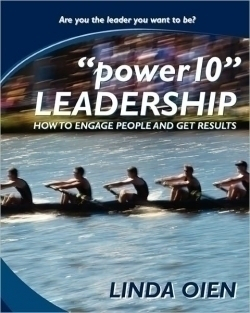"power 10" Leadership
Author Linda Oien’s book, “power 10“ Leadership*, bills itself as a guide for creating productive, empowered employees while avoiding a top-down management style. Linda Oien practices what she preaches. She doesn’t lecture on how to manage. She provides a toolkit that allows managers to evaluate their leadership style and involve their staff in management decisions. Using a series of process-driven charts, the manager and staff members first evaluate the needs of their organization. Then, selecting from chapters that address these particular needs, they set about creating behaviors that provide personal satisfaction, powerful teams, and a successful organization.
Business managers will feel at home with this book. They will find management tips; motivational slogans suitable for overlaying on nature scene posters; alarming statistics supporting the deplorable state of business management; ample charts; and, of course, the inspirational metaphor. The advice is germane; neither the slogans nor the statistics are overdone, the metaphor is sustained, and the charts are the real strength of the book.
A single template is applied to various charts featured throughout the book. A column on the left lists factors that indicate poor performance in a category. For example, “There is not a defined method for reinforcing the application of newly acquired skills on the job.” A center column provides a rating scale from one through seven. The right-hand column, “Where We Need to Be,” lists ideal outcomes such as, “There is an effective method for reinforcing the application of skills and knowledge gained through training.” These charts are used to evaluate effectiveness in categories that include delegation, problem solving, communication, and team development. Once weaknesses are revealed, additional charts help management and staff develop a plan for addressing them. The author is quick to point out that not all organizations are the same and that teams must define how they will work together. Once a need is revealed, the reader skips directly to the indicated chapter of drills that address the salient problem.
The metaphor employed by Oien is the leader as the Coxswain of a rowing team. “Power 10” is a rowing term. The Coxswain who calls for a power 10 is asking for ten, perfectly timed, powerful strokes—a strategy used to pull ahead of a competitor. “…having everyone in the boat rowing the same direction will move the boat swiftly toward the finish line,” she writes. “Your people need to understand where they fit in the overall picture and have a clear line-of-sight for how their contributions support overall success.”
Oien gets the metaphor right and the process, too. She is a management consultant, speaker, and former Fortune 500 executive. This book is a companion to her consulting service. The workplace has become increasingly corporate. If statistics can be believed, workers are not happy about it. This book provides effective tools for getting them all onboard and rowing together.
Reviewed by
Marilyn Berry
Disclosure: This article is not an endorsement, but a review. The publisher of this book provided free copies of the book and paid a small fee to have their book reviewed by a professional reviewer. Foreword Reviews and Clarion Reviews make no guarantee that the publisher will receive a positive review. Foreword Magazine, Inc. is disclosing this in accordance with the Federal Trade Commission’s 16 CFR, Part 255.

